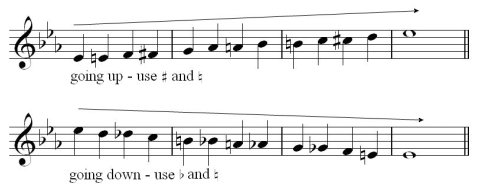

There are chromatic notes between A-B, C-D, D-E, F-G, and G-A. These are notated by the black keys on the piano.

In between these notes, there are some half-steps or chromatic notes. We normally call them by their letter: A, B, C, D, E, F, and G. We will be looking at this in depth soon in a special section dealing with the Major Scale.There are 7 diatonic pitches. This means that once you know this sequence of intervals you can play all 12 major scales! This is the sort of thing that makes music theory very useful. Play that sequence of intervals on your guitar - start from any note you like and you will be playing the major scale for it! Or - to keep things less wordy, just remember the following sequence of fret distances: The good news is that whatever note you start with, if you apply the following sequence of intervals - you will always get the major scale for that note!

Remember - The reason we have scales is simply this - some notes work well with each other and others don't! The A major scale will sound good, the chromatic scale won't sound so good in places. Listen to how the scales in the ActionTab work with the A you are playing on your guitar. As the ActionTab is playing, strum out an A major chord on your guitar (or even just the open A note if you don't know the A major chord yet). This becomes particularly clear whenever playing over an A major chord. Play both scales and you should hear the difference between them. It is a scale which includes the notes with the strongest harmonic relationships. The major scale is a great way of showing this. Scales are a way of arranging notes according to the strength of their harmonic relationships. In fact some notes don't sound good together at all. But the main reason is simple enough - some notes work better together than others. Well, there are a number of reasons, and some of those will become very apparent when we look at playing with chords. Now why do this? Why not just use the chromatic scale all the time? After all it contains every note! Root A - B - C# - D - E - F# - G# - A (octave) Notice that the only difference between the A chromatic scale and the A major scale is that we skip some notes in the A major scale. This A major scale is the second scale you will see in the ActionTab. Root - tone - tone - semitone - tone - tone - tone - semitone (octave) If we apply the following sequence of intervals (tones and semitones) to the A chromatic scale we will get the A major scale: Read the article on Intervals in the Fundamentals Section if you are lost! There are 2 types of interval - the TONE and the SEMITONE. To get other scales we apply intervals to it. Root A - A# - B - C - C# - D - D# - E - F - F# - G - G# - A (octave)Īs mentioned earlier the chromatic scale is the father of all other scales. In this ActionTab we start by playing out the A chromatic scale again along the A string. So far in this section we have played out the A chromatic scale and C chromatic scale along 1 string. Because there are 12 notes, there are 12 possible chromatic scales. The note you begin from (the root note) tells you which chromatic scale you are playing. 'Chromatic' just means we play every possible note (there are 12) from the root note to the next octave note. So far in the Music Theory Fundamentals Section we have begun by playing the father of all scales - the chromatic scale. A scale is a sequence of notes played in a definite order.


 0 kommentar(er)
0 kommentar(er)
